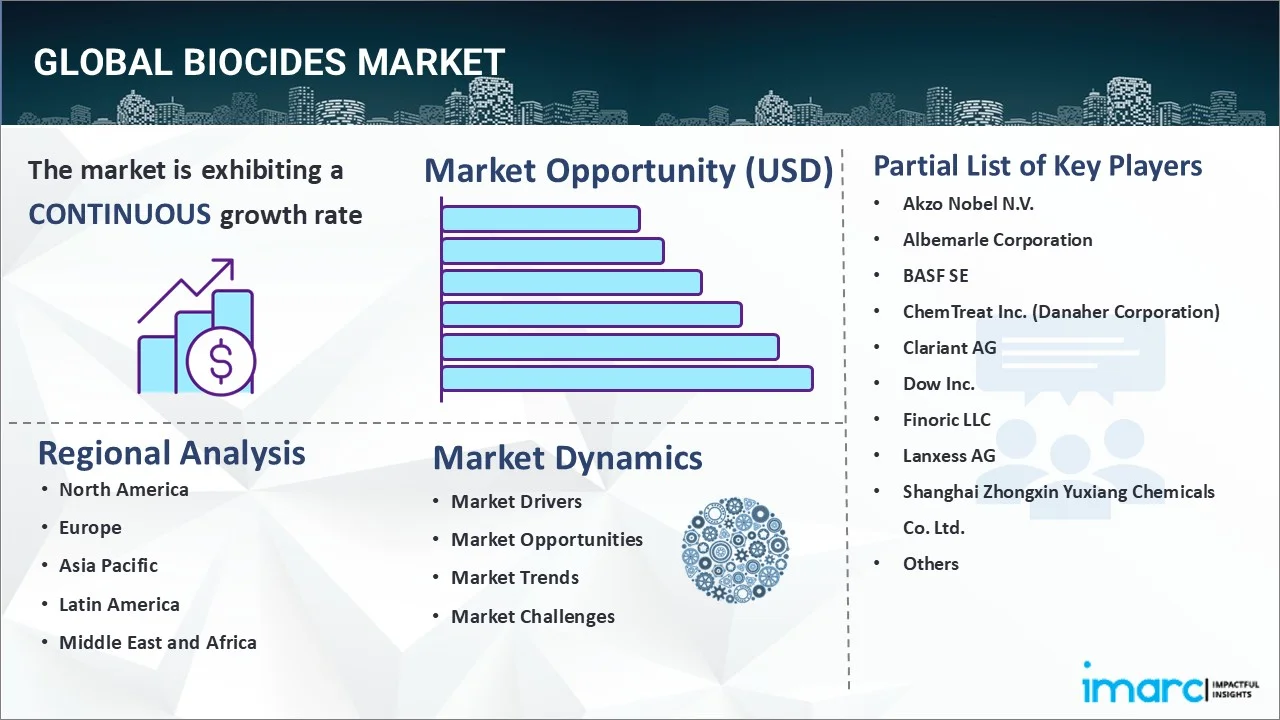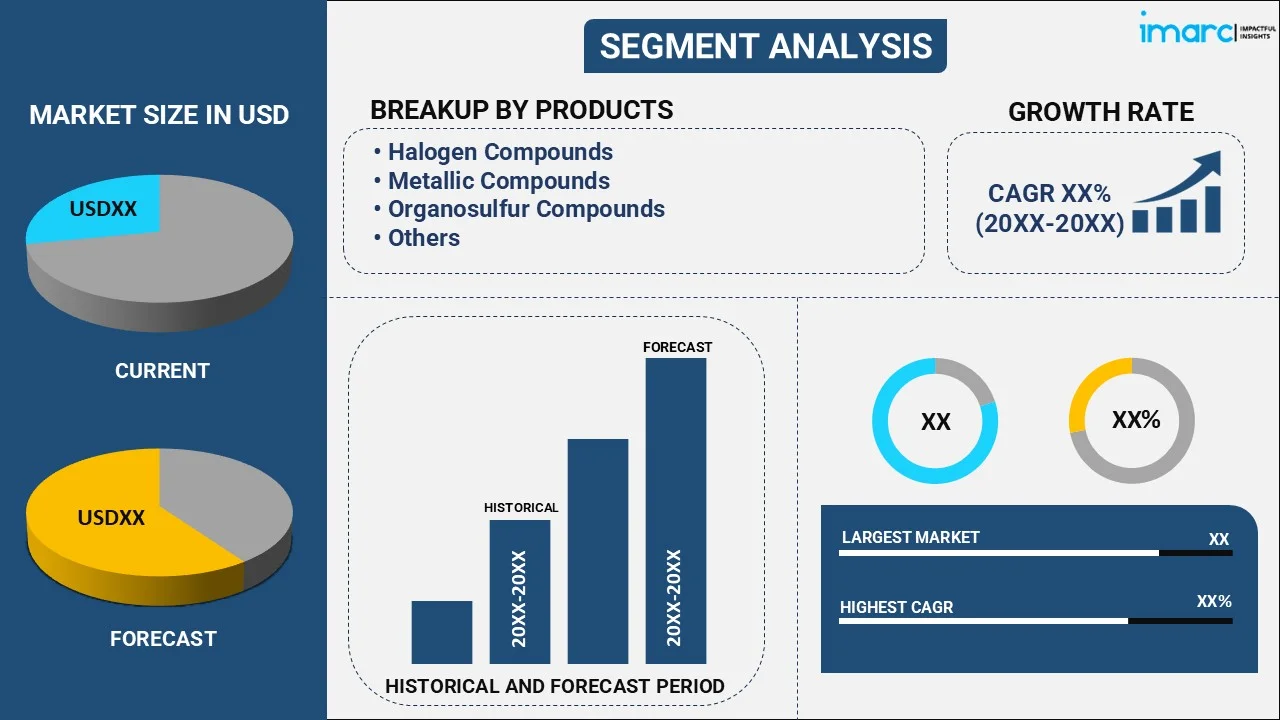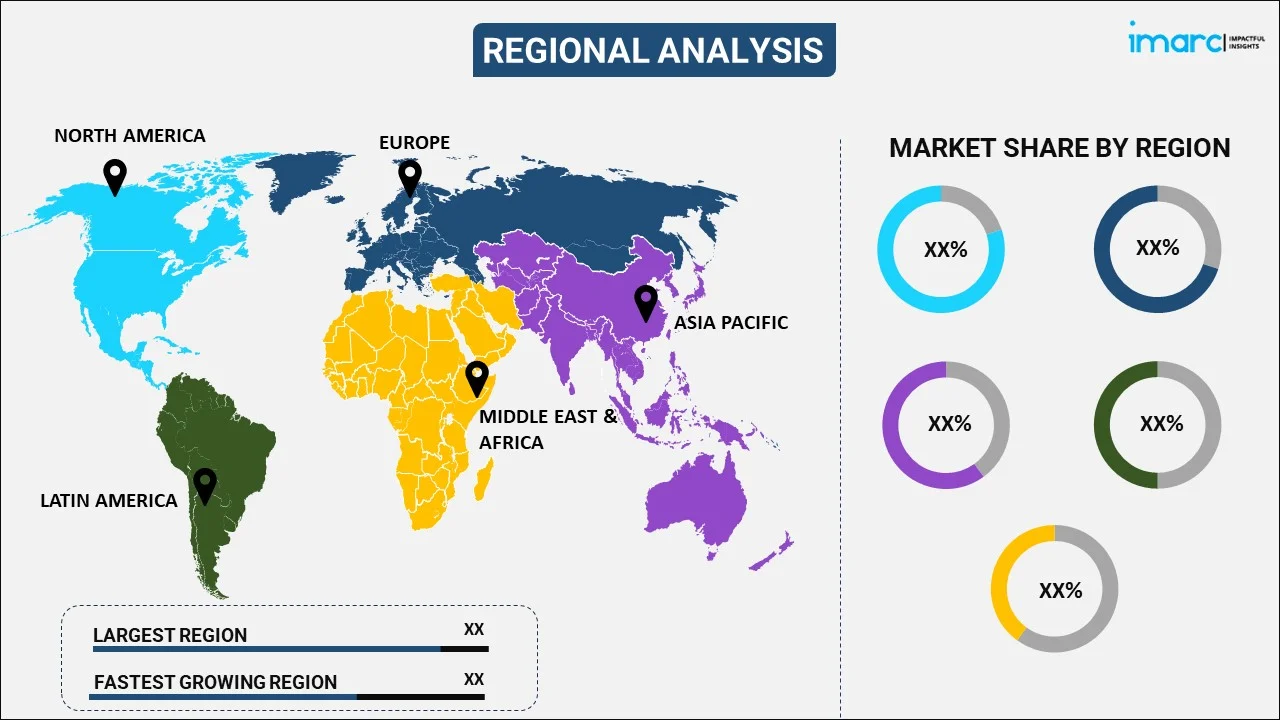
Biocides Market Report by Product (Halogen Compounds, Metallic Compounds, Organosulfur Compounds, Organic Acids, Phenolics, and Others), Application (Water Treatment, Food and Beverage, Personal Care, Wood Preservation, Paints and Coatings, Construction, and Others), and Region 2025-2033
Biocides Market Size:
The global biocides market size reached USD 9.5 Billion in 2024. Looking forward, IMARC Group expects the market to reach USD 13.9 Billion by 2033, exhibiting a growth rate (CAGR) of 4.12% during 2025-2033. The increasing need for wastewater treatment solutions, the rising demand for clean and potable water, regulatory compliance promoting the use of biocides to maintain the health standards of individuals, and the growing product demand in producing cleaning agents are driving the biocides market value.
|
Report Attribute
|
Key Statistics
|
|---|---|
|
Base Year
|
2024
|
|
Forecast Years
|
2025-2033
|
|
Historical Years
|
2019-2024
|
|
Market Size in 2024
|
USD 9.5 Billion |
|
Market Forecast in 2033
|
USD 13.9 Billion |
| Market Growth Rate (2025-2033) | 4.12% |
Biocides Market Analysis:
- Major Market Drivers: The increasing demand for wastewater treatment solutions and the rising need for clean water are driving the biocides market revenue.
- Key Market Trends: The growing trend of sustainable biocide formulations is driving the biocides market overview.
- Geographical Trends: Asia Pacific leads the biocides market demand due to the increasing demand for clean water and the rising product demand in many industries.
- Competitive Landscape: Akzo Nobel N.V. and Solvay S.A., among many others are some of the market players driving the biocides market outlook.
- Challenges and Opportunities: The complex and changing regulatory landscape is challenging the biocides market research. The increasing demand for antimicrobial solutions is an opportunity.

Biocides Market Trends:
Increasing awareness of health and hygiene
The biocides market growth is driven by increasing awareness about the significance of maintaining clean and hygienic environments in healthcare facilities, food processing plants, and public spaces. Both consumers and industries rank microbial control among their top concerns in products and processes as it helps to check diseases and infections. Moreover, there has been an increase in demand for antimicrobial products and disinfection solutions due to the COVID-19 pandemic, which has raised awareness of biocides' role in infection control and prevention. The biocides market share has never experienced such a boom, with people and businesses prioritizing health measures to curb viral transmissions.
Technological advancements and innovation
There is ongoing research resulting in the development of new biocide formulations with improved efficacy, safety, and environmental profiles. Technological advancements have made it possible to develop biocides that target specific organisms better than previous ones while also being more sustainable, leading to market growth whereby they meet ever-changing demands from customers. Researchers are now focusing on making biocide formulations sustainable and eco-friendly. These advancements align with the increasing demand for sustainable and environmentally friendly solutions, driving the biocides market forecast further.
Regulatory Compliance
Regulatory compliance plays a tremendous role in fueling the market growth of biocides. Public health and environmental protection have become a center of attention for all the countries globally for which the government is imposing stringent regulations to address the concerns. Regulatory compliance promotes the use of biocides to maintain the public safety and health standards of individuals. Biocides have acquired attention in the healthcare, agriculture, and industrial sectors to regulate and prevent the production of harmful pathogens or bacteria. Several countries across the globe use biocidal products to uphold sustainability, efficiency, productivity, and safety standards. Biocides are essential for maintaining health, stopping the spread of dangerous illnesses, and controlling the growth of bacteria. The biocide market is expanding significantly with firm compliance with regulations.
Biocides Industry Segmentation:
IMARC Group provides an analysis of the key trends in each segment of the market, along with forecasts at the global, regional, and country levels for 2025-2033. Our report has categorized the market based on product and application.
Breakup by Product:

- Halogen Compounds
- Metallic Compounds
- Organosulfur Compounds
- Organic Acids
- Phenolics
- Others
Halogen compounds account for the majority of the market share
The report has provided a detailed breakup and analysis of the market based on the product. This includes halogen compounds, metallic compounds, organosulfur compounds, organic acids, phenolics, and others. According to the report, halogen compounds represented the largest segment.
Biocides that are halogenated, in particular, chlorinated, brominated, and iodinated ones, are driving the market due to their strong antimicrobial activities. Water treatment, industrial processes, healthcare as well as agriculture are some of the industries that make extensive use of these compounds for microbial control. Some qualities that have made halogen-based biocides worth considering include a wider range of action against viruses, algae, fungi, and bacteria, helping to ensure safety and hygiene in products. Besides, they often last long and remain unchanged over a long period, making them favorable options for different uses. The demand for halogen-based biocides is expected to rise due to increasing importance being placed on higher levels of hygiene by industries while environmental regulations change, thereby driving market growth and innovation in biocide formulations.
Breakup by Application:
- Water Treatment
- Food and Beverage
- Personal Care
- Wood Preservation
- Paints and Coatings
- Construction
- Others
Paints and coatings hold the largest share of the industry
A detailed breakup and analysis of the market based on the application have also been provided in the report. This includes water treatment, food and beverage, personal care, wood preservation, paints and coatings, construction, and others. According to the report, paints and coatings accounted for the largest market share.
The paints and coatings industry is using biocides to prevent microbial contamination and degradation in formulations. Biocides serve as critical additives protecting paints and coatings from microbial attack hence extending shelf life as well as maintaining performance. Thus, given the increasing need for durable coatings that are high quality within the construction, automotive, and industrial sectors, effective microorganism control becomes necessary. Product integrity is preserved by biocides, which provide continuous protection from fungi, bacteria, or algae, hence enhancing sustainability.
Breakup by Region:

- North America
- United States
- Canada
- Asia-Pacific
- China
- Japan
- India
- South Korea
- Australia
- Indonesia
- Others
- Europe
- Germany
- France
- United Kingdom
- Italy
- Spain
- Russia
- Others
- Latin America
- Brazil
- Mexico
- Others
- Middle East and Africa
Asia-Pacific leads the market, accounting for the largest biocides market share
The market research report has also provided a comprehensive analysis of all the major regional markets, which include North America (the United States and Canada); Asia-Pacific (China, Japan, India, South Korea, Australia, Indonesia, and others); Europe (Germany, France, the United Kingdom, Italy, Spain, Russia, and others); Latin America (Brazil, Mexico, and others); and the Middle East and Africa. According to the report, Asia-Pacific accounted for the largest market share.
The Asia-Pacific is a significant propeller of biocide market growth due to quick industrialization and urbanization as well as increasing concerns about hygiene. There are growing populations in this region, which increases demand for water treatment, agriculture, healthcare, and construction, hence promoting the use of biocides. Another factor that contributes to the industry’s growth is strict regulatory policies forcing manufacturers to use preservatives in their products, as well as other measures to prevent the growth of harmful microbes. Besides, rapid infrastructure development and manufacturing activities necessitate the use of biocides to eliminate microbes. China was the country in the Asia-Pacific region with the highest investment in infrastructure in 2020. With extensive infrastructure development projects across various sectors, there is a heightened demand for biocides to ensure the durability and longevity of these structures.
Leading Key Players in the Biocides Industry:
Key players in this market contribute significantly towards its growth through strategic investments in research and development (R&D), product innovation, and new market expansion strategies. These firms consistently invent better formulations of biocides, which meet evolving legal demands alongside emerging microbial challenges within diverse industries. On top of all this, it is only through these key players with wide-reaching distribution networks as well as a robust presence within various sectors that new markets become accessible while still meeting diverse consumer needs. Also, some companies can use partnerships with others or merger opportunities to ensure their positions in the market are maintained at high levels while competition also goes up steadily.
The market research report has provided a comprehensive analysis of the competitive landscape. Detailed profiles of all major companies have also been provided. Some of the key players in the market include:
- Akzo Nobel N.V.
- Albemarle Corporation
- BASF SE
- ChemTreat Inc. (Danaher Corporation)
- Clariant AG
- Dow Inc.
- Finoric LLC
- Lanxess AG
- Shanghai Zhongxin Yuxiang Chemicals Co. Ltd.
- Solvay S.A.
- The Lubrizol Corporation (Berkshire Hathaway Inc.)
- Troy Corporation
- Wuxi Honor Shine Chemical Co. Ltd
(Please note that this is only a partial list of the key players, and the complete list is provided in the report.)
Latest News:
- March 15, 2024: AkzoNobel announced that it will boost the capabilities of North American powder coatings sites.
- February 20, 2024: Albemarle Corporation announced a definitive agreement with the BMW Group to deliver battery-grade lithium to help the automaker pursue high-performance electric vehicles (EVs).
- March 28, 2024: BASF SE has announced that it will showcase consumer products made with bio-based Ultramid polyamide at CHINAPLAS 2024. The company co-created smart glasses with Huawei. These glasses contain 39% bio-content in the glasses temple.
Biocides Market Report Scope:
| Report Features | Details |
|---|---|
| Base Year of the Analysis | 2024 |
| Historical Period | 2019-2024 |
| Forecast Period | 2025-2033 |
| Units | Billion USD |
| Scope of the Report | Exploration of Historical Trends and Market Outlook, Industry Catalysts and Challenges, Segment-Wise Historical and Future Market Assessment:
|
| Products Covered | Halogen Compounds, Metallic Compounds, Organosulfur Compounds, Organic Acids, Phenolics, Others |
| Applications Covered | Water Treatment, Food and Beverage, Personal Care, Wood Preservation, Paints and Coatings, Construction, Others |
| Regions Covered | Asia Pacific, Europe, North America, Latin America, Middle East and Africa |
| Countries Covered | United States, Canada, Germany, France, United Kingdom, Italy, Spain, Russia, China, Japan, India, South Korea, Australia, Indonesia, Brazil, Mexico |
| Companies Covered | Akzo Nobel N.V., Albemarle Corporation, BASF SE, ChemTreat Inc. (Danaher Corporation), Clariant AG, Dow Inc., Finoric LLC, Lanxess AG, Shanghai Zhongxin Yuxiang Chemicals Co. Ltd., Solvay S.A., The Lubrizol Corporation (Berkshire Hathaway Inc.), Troy Corporation, Wuxi Honor Shine Chemical Co. Ltd, etc. |
| Customization Scope | 10% Free Customization |
| Post-Sale Analyst Support | 10-12 Weeks |
| Delivery Format | PDF and Excel through Email (We can also provide the editable version of the report in PPT/Word format on special request) |
Key Questions Answered in This Report:
- How has the global biocides market performed so far, and how will it perform in the coming years?
- What are the drivers, restraints, and opportunities in the global biocides market?
- What is the impact of each driver, restraint, and opportunity on the global biocides market?
- What are the key regional markets?
- Which countries represent the most attractive biocides market?
- How big is the global biocides market?
- What is the breakup of the market based on the product?
- Which is the most attractive product in the biocides market?
- What is the breakup of the market based on the application?
- Which is the most attractive application in the biocides market?
- What is the competitive structure of the market?
- Who are the key players/companies in the global biocides market?
Key Benefits for Stakeholders:
- IMARC’s industry report offers a comprehensive quantitative analysis of various market segments, historical and current market trends, market forecasts, and dynamics of the biocides market from 2019-2033.
- The research report provides the latest information on the market drivers, challenges, and opportunities in the global biocides market.
- The study maps the leading, as well as the fastest-growing, regional markets. It further enables stakeholders to identify the key country-level markets within each region.
- Porter's five forces analysis assists stakeholders in assessing the impact of new entrants, competitive rivalry, supplier power, buyer power, and the threat of substitution. It helps stakeholders to analyze the level of competition within the biocides industry and its attractiveness.
- The competitive landscape allows stakeholders to understand their competitive environment and provides insight into the current positions of key players in the market.
Need more help?
- Speak to our experienced analysts for insights on the current market scenarios.
- Include additional segments and countries to customize the report as per your requirement.
- Gain an unparalleled competitive advantage in your domain by understanding how to utilize the report and positively impacting your operations and revenue.
- For further assistance, please connect with our analysts.
 Inquire Before Buying
Inquire Before Buying
 Speak to an Analyst
Speak to an Analyst
 Request Brochure
Request Brochure
 Request Customization
Request Customization




.webp)




.webp)












